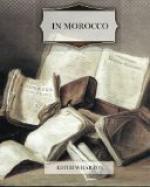In the Medersa of the Oudayas, these native activities have been replaced by the lifeless hush of a museum. The rooms are furnished with old rugs, pottery, brasses, the curious embroidered hangings which line the tents of the chiefs, and other specimens of Arab art. One room reproduces a barber’s shop in the bazaar, its benches covered with fine matting, the hanging mirror inlaid with mother-of-pearl, the razor-handles of silver niello. The horseshoe arches of the outer gallery look out on orange-blossoms, roses and the sea. It is all beautiful, calm and harmonious; and if one is tempted to mourn the absence of life and local colour, one has only to visit an abandoned Medersa to see that, but for French intervention, the charming colonnades and cedar chambers of the college of the Oudayas would by this time be a heap of undistinguished rubbish—for plaster and rubble do not “die in beauty” like the firm stones of Rome.
V
ROBINSON CRUSOE’S “SALLEE”
Before Morocco passed under the rule of the great governor who now administers it, the European colonists made short work of the beauty and privacy of the old Arab towns in which they established themselves.
On the west coast, especially, where the Mediterranean peoples, from the Phenicians to the Portuguese, have had trading-posts for over two thousand years, the harm done to such seaboard towns as Tangier, Rabat and Casablanca is hard to estimate. The modern European colonist apparently imagined that to plant his warehouses, cafes and cinema-palaces within the walls which for so long had fiercely excluded him was the most impressive way of proclaiming his domination.
Under General Lyautey such views are no longer tolerated. Respect for native habits, native beliefs and native architecture is the first principle inculcated in the civil servants attached to his administration. Not only does he require that the native towns shall be kept intact, and no European building erected within them; a sense of beauty not often vouchsafed to Colonial governors causes him to place the administration buildings so far beyond the walls that the modern colony grouped around them remains entirely distinct from the old town, instead of growing out of it like an ugly excrescence.
The Arab quarter of Rabat was already irreparably disfigured when General Lyautey came to Morocco; but ferocious old Sale, Phenician counting-house and breeder of Barbary pirates, had been saved from profanation by its Moslem fanaticism. Few Christian feet had entered its walls except those of the prisoners who, like Robinson Crusoe, slaved for the wealthy merchants in its mysterious terraced houses. Not till two or three years ago was it completely pacified; and when it opened its gates to the infidel it was still, as it is to-day, the type of the untouched Moroccan city—so untouched that, with the sunlight irradiating its cream-coloured walls and the blue-white domes above them, it rests on its carpet of rich fruit-gardens like some rare specimen of Arab art on a strip of old Oriental velvet.




